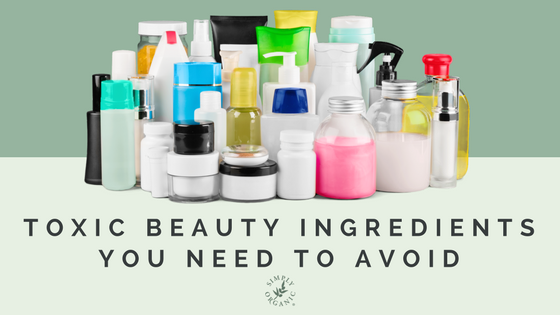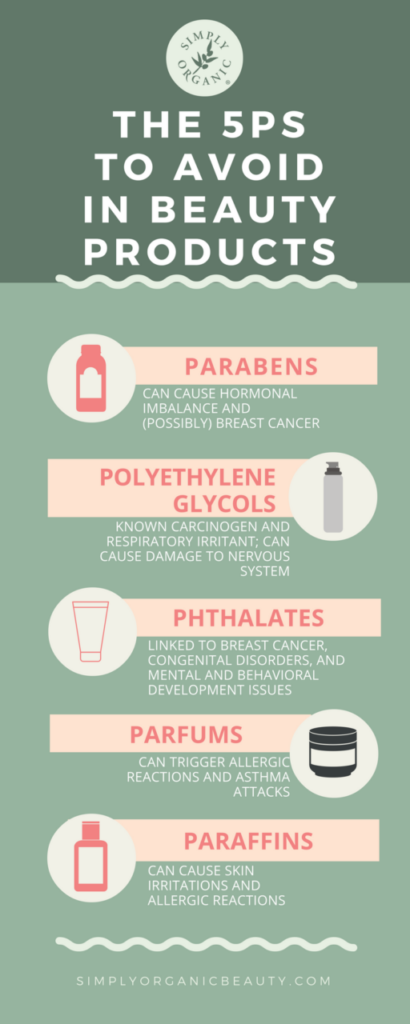
On your path to living a more non-toxic lifestyle, you may discover tons of harmful chemicals in your favorite beauty products. It’s virtually impossible to remember every single one of them, but it’s important to learn at least some before you slather them on your client’s hair and skin. When you read the labels, make sure to look out for these five toxic ingredients in beauty products.
PARABENS
Parabens are preservatives used widely for cosmetic and personal care products. Many health-conscious clients put this ingredient on top of their list of things to avoid, and rightfully so.
Why avoid them: In 2011, a study found that 99% of the breast tissue samples collected for the research contained at least one paraben.1 Parabens are known to mimic estrogen, resulting in high levels of estrogen in the body which can cause hormonal imbalance and possibly breast cancer. According to the American Chemical Society, more than 85% of personal care products contain parabens. They give products a longer shelf life, but they become toxic when applied. As soon as they come in contact with the skin, they easily penetrate the body and enter the bloodstream.
POLYETHYLENE GLYCOLS
One of the ingredients you might want to stay away from is polyethylene glycols (PEGs). PEGs are synthetic petrochemicals commonly used in skincare and hair color products as thickeners, softeners, and solvents. They help enhance the absorption of ingredients into the skin, including the harmful ones.
Why avoid them: It has been found that PEGs contain impurities, which include ethylene oxide and 1,4-dioxane. These two are known carcinogens and respiratory irritants. Long-term exposure to ethylene oxide can cause serious health consequences, including damage to the nervous system. In fact, this chemical was used as nerve gas in World War I. Another concern about PEGs is their penetration enhancement effects, and is why we recommend avoiding PEGs in your hair color products. However, there are also studies claiming PEGs with a molecular weight of 200 to over 10,000 are considered harmless, as long as they are not applied to damaged skin.2 But why bother when there are many products out there that are PEG-free?
 PHTHALATES
PHTHALATES
Commonly used to make plastic achieve more malleable properties, phthalates are also found in some beauty products such as hair spray, nail polish, and solvent. Phthalates are often listed as dibutyl phthalate (DBP), dimethyl phthalate (DMP), and diethyl phthalate (DEP). Even if you can’t find any of these on the label, keep in mind that many plastic containers contain phthalates, which can leach into the product and put you and your client at risk of exposure.
Why avoid them: As useful as phthalates are, several studies have found a link to breast cancer and congenital disorders.3 Research also suggests that exposure to this ingredient can affect the mental and behavioral development of children. Apart from that, the United States Environmental Protection Agency classifies phthalates (DEP) as Priority and Toxic Pollutant due to its harmful effects on wildlife and the environment.4
Our solution: One of the best ways to avoid phthalates is to choose glass packaging for your products. Glass is pure, natural and protective, and there are countless more reasons to choose glass for your salon products.
PARFUMS
Ah, who doesn’t love scented products? We all want to smell nice and fresh all throughout the day, but at what cost? Parfums are one of the most toxic things you can put on your skin. You can easily detect this ingredient as some companies usually list it as “fragrance.”
Why avoid them: Parfum is one of the top known allergens in beauty products. Some can even trigger neurological problems and asthma attacks, according to the Environmental Working Group (EWG). The scary thing about this ingredient is no one exactly knows its component as companies are not required to disclose the chemicals they mixed to create the scent. Some of them are used to make the fragrance linger in the air, causing other people allergic to synthetic perfume to feel ill. Touted as the new secondhand smoke, parfums do not only put your own health at risk, but also the health of those around you. Once an individual is sensitized to a particular chemical or irritant, allergic reactions can last a lifetime.
Our solution: Avoid allergies and sensitization by choosing beauty products using pure essential oils to add scent to their products! One of our favorites are organic styling products from Oway – they use only pure, steam-distilled essential oils from their family farms in Italy.
PARAFFINS
You may have heard this in spas or read in labels of skin creams or ointments. Paraffin, also called mineral oil, is a mixture derived from crude oil.
Why avoid them: Crude oil or petroleum is a known occlusive agent, which means products that contain this ingredient just sit on the skin and is not necessarily absorbed. Due to its greasy consistency, it gives the illusion of moisture, when in fact, it just seals off the pores preventing the skin from breathing — thereby causing skin irritations and allergic reactions.
Unfortunately, the US Food and Drug Administration has no authority over beauty companies, and therefore cannot require their products to be tested for safety, unless their products contain color additives and ingredients considered as over-the-counter drugs.5 The industry is extremely unregulated that any company can practically put any ingredient they please without FDA approval. But thanks to independent organizations like the Environmental Working Group (EWG), Campaign for Safe Cosmetics, ConsumerLab, among others, consumers are becoming more conscious of the products they’re using. As artists and purveyors of holistic, environmentally friendly beauty products, it is also our duty to give our clientele the safest and healthiest services they deserve.
Sources
1 Darbre, P.D. et al. (2012). Measurement of paraben concentrations in human breast tissue at serial locations across breast from axilla to sternum. Available: http://www.theorganicpharmacy.com/images/content/expertadvice/factsheets/files/462.pdf
2 Pollot, C. (2005). Safety assessment on polyethylene glycols (PEGs) and their derivatives as used in cosmetic products. Available: http://www.sciencedirect.com/science/article/pii/S0300483X05002696
3 Westervelt, A. (2015). Phthalates are everywhere, and the health risks are worrying. How bad are they really? Available: https://www.theguardian.com/lifeandstyle/2015/feb/10/phthalates-plastics-chemicals-research-analysis
4 U.S. Environmental Protection Agency. (2014). Code of Federal Regulations: Protection of Environment. Available: https://www.gpo.gov/fdsys/pkg/CFR-2014-title40-vol29/xml/CFR-2014-title40-vol29-sec401-15.xml
5 U.S. Food and Drug Administration. (2012). Is it a cosmetic, a drug, or both? (Or is it soap?). Available: http://www.fda.gov/Cosmetics/GuidanceRegulation/LawsRegulations/ucm074201.htm




